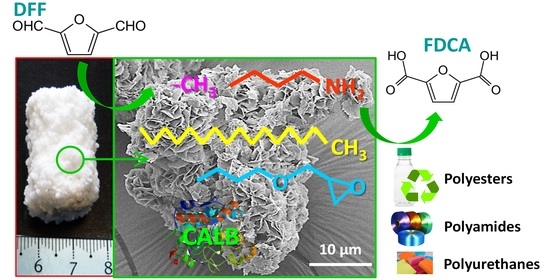Effect of Functional Group on the Catalytic Activity of Lipase B from Candida antarctica Immobilized in a Silica-Reinforced Pluronic F127/α-Cyclodextrin Hydrogel
Abstract
:1. Introduction
2. Results
2.1. Silicification of the Pluronic F127/α-CD Hydrogel
2.2. Effect of Functionnal Groups
2.2.1. Method for Surface Functionalization and Immobilization of CALB
2.2.2. Characterization of Biocatalysts
- (a)
- Sihgel@CTMS@GPTMS@CALB
- (b)
- Sihgel@HDTMS@APTMS@CALB
- (c)
- Sihgel@CTMS@APTMS@CALB: Effect of the linker (glutaric anhydride vs. glutaraldehyde)
3. Catalytic Activity
4. Recyclability
5. Conclusions
6. Experimental
6.1. Materials
6.2. Preparation of Silicified Hydrogel
6.3. Functionalization of Silicified Hydrogel
- (i)
- Sihgel@CTMS@GPTMS. Surface functionalization with GPTMS and CTMS was carried out according to a method reported earlier by Renard et al. [61] with some modifications. Typically, 250 mg of dried Sihgel was introduced in 25 mL toluene together with 175 μL CTMS (0.054 M, CTMS/SiO2 = 0.33) and 750 μL GPTMS (0.113 M, GPTMS/SiO2 = 0.68). The mixture was maintained under reflux at 100 °C for 16 h. Reaction was performed in toluene because non-polar solvents have been reported to facilitate aggregation of silane ligands on the silica surface, thus favoring interaction with silanol groups [48,62]. The solid was collected by centrifugation, then washed with water and ethanol and finally dried under vacuum conditions at 25 °C for 10 h. GPTMS/SiO2 molar ratio was varied between 0.34 and 1.5 while CTMS/SiO2 one was fixed to 0.33 or 0.66.
- (ii)
- Sihgel@HDTMS@APTMS-GAH. Surface functionalization with APTMS was carried out according to two methods reported earlier on conventional silica by Sorensen et al. [63] and Kao et al. [64] with some modifications. Typically, 250 mg of silicified hydrogel was suspended in 25 mL of anhydrous toluene, followed by successive addition of 630 µL HDTMS (0.055 M, HDTMS/SiO2 = 0.33) and 122 µL APTMS (0.027 M, APTMS/SiO2 = 0.16). Because of its high degree of hydrophobicity, HDTMS was hydrolyzed first in an oxalic acid solution (0.1 M oxalic acid) before grafting. After refluxing at 100 °C for 24 h, the solid denoted Sihgel@HDTMS@APTMS was collected by centrifugation, washed several times with toluene, then dried under vacuum and finally stored under inert (N2) atmosphere. Subsequently, 50 mg of the functionalized Sihgel@HDTMS@APTMS material was dispersed in 1.5 mL acetate buffer (pH 4.6) and 77 µL glutaraldehyde (GAH) was added (GAH/APTMS = 3.1). After stirring at room temperature for 10 h, the GAH cross-linked material (denoted Sihgel@HDTMS@APTMS-GAH) was collected by centrifugation, then washed with water and ethanol and finally dried under vacuum conditions at 25 °C for 10 h.
- (iii)
- Sihgel@CTMS@APTMS-GAH(GAC). Typically, 250 mg silicified hydrogel was suspended in 25 mL of anhydrous toluene, followed by successive addition of 175 µL CTMS (0.054 M, CTMS/SiO2 = 0.33) and 122 µL APTMS (0.027 M, APTMS/SiO2 = 0.16). After refluxing at 100 °C for 24 h, the solid denoted Sihgel@CTMS@APTMS was collected by centrifugation, washed several times with toluene, then dried under vacuum and stored under inert (N2) atmosphere. Subsequently, 50 mg of the functionalized Sihgel@CTMS@APTMS material was dispersed in 1.5 mL acetate buffer (pH 4.6) and 77 µL of glutaraldehyde (GAH) was added (GAH/APTMS = 3.1). After stirring at room temperature for 10 h, the GAH cross-linked material (denoted Sihgel@CTMS@APTMS-GAH) was collected by centrifugation, then washed with water and ethanol and finally dried under vacuum conditions at 25 °C for 10 h. In another synthesis, glutaric anhydride (GAC) was employed as a linker. Typically, 50 mg of Sihgel@CTMS was dispersed in 1.5 mL DMF, then 50 mg·GAC was added (GAC/APTMS = 3.2). The mixture was stirred at room temperature for 1 h, then refluxed at 60 °C for 9 h. The solid was recovered by centrifugation, then washed with water and ethanol and finally dried under vacuum.
6.4. Immobilization of Lipase B from Candida Antarctica
6.5. Characterization Methods
6.6. Activity Measurements
Supplementary Materials
Author Contributions
Funding
Institutional Review Board Statement
Informed Consent Statement
Data Availability Statement
Acknowledgments
Conflicts of Interest
Abbreviations
| CD | Cyclodextrin |
| Pluronic F127 | PEO100PPO70PEO100 PEO: poly(ethylene oxide) and PPO: poly(propylene oxide) |
| CALB | Lipase B from Candida antarctica |
| TMOS | Tetramethyl orthosilicate |
| CTMS | Chlorotrimethylsilane |
| HDTMS | Hexadecyltrimethoxysilane |
| APTMS | (3-aminopropyl)-trimethoxysilane |
| GPTMS | (3-Glycidyloxypropyl)trimethoxysilane |
| GAH | Glutaraldehyde |
| GAC | Glutaric anhydride |
| EDC | N-(3-Dimethylaminopropyl)-N′-ethylcarbodiimide hydrochloride |
| CCLβ-CD | Cationic cross-linked β-CD |
| EP | Epichlorohydrin |
| GTMAC | Glycidyltrimethylammonium chloride |
| DFF | 2,5-diformylfuran |
| FDCA | 2,5-furandicarboxylic acid |
| FFCA | 5-formylfuran-2-carboxylic acid |
| DLS | Dynamic Light Scattering |
| SBET | Surface area determined by the Brunauer, Emmett and Teller method |
| BJH | Barrett, Joyner and Halenda |
| TEM | Transmission Electron Microscopy |
| SEM | Scanning Electron Microscopy |
| NMR | Nuclear Magnetic Resonance |
| HPLC | High Performance Liquid Chromatography |
| ATR-FTIR | Attenuated Total Reflexion Fourier Transform Infrared spectroscopy |
| TGA | Thermogravimetric analysis |
| Dg | Grafting density |
| Dgmax | Maximum grafting density |
| Scov | Surface coverage |
References
- Blettler, M.C.; Abrial, E.; Khan, F.R.; Sivri, N.; Espinola, L.A. Freshwater plastic pollution: Recognizing research biases and identifying knowledge gaps. Water Res. 2018, 143, 416–424. [Google Scholar] [CrossRef] [PubMed] [Green Version]
- Gallezot, P. Conversion of biomass to selected chemical products. Chem. Soc. Rev. 2012, 41, 1538–1558. [Google Scholar] [CrossRef] [PubMed]
- Gross, R.A.; Kalra, B. Biodegradable Polymers for the Environment. Science 2002, 297, 803–807. [Google Scholar] [CrossRef] [PubMed] [Green Version]
- Binder, J.B.; Raines, R. Simple Chemical Transformation of Lignocellulosic Biomass into Furans for Fuels and Chemicals. J. Am. Chem. Soc. 2009, 131, 1979–1985. [Google Scholar] [CrossRef] [PubMed]
- Cho, E.J.; Trinh, L.T.P.; Song, Y.; Lee, Y.G.; Bae, H.-J. Bioconversion of biomass waste into high value chemicals. Bioresour. Technol. 2019, 298, 122386. [Google Scholar] [CrossRef]
- European-Bioplastics. Available online: https://www.european-bioplastics.org/market/ (accessed on 7 October 2021).
- Sheldon, R.A. Green and sustainable manufacture of chemicals from biomass: State of the art. Green Chem. 2013, 16, 950–963. [Google Scholar] [CrossRef]
- Zhang, Z.; Deng, K. Recent Advances in the Catalytic Synthesis of 2,5-Furandicarboxylic Acid and Its Derivatives. ACS Catal. 2015, 5, 6529–6544. [Google Scholar] [CrossRef]
- Motagamwala, A.H.; Won, W.; Sener, C.; Alonso, D.M.; Maravelias, C.T.; Dumesic, J.A. Toward biomass-derived renewable plastics: Production of 2,5-furandicarboxylic acid from fructose. Sci. Adv. 2018, 4, eaap9722. [Google Scholar] [CrossRef] [Green Version]
- Sheldon, R.A.; van Pelt, S. Enzyme immobilisation in biocatalysis: Why, what and how. Chem. Soc. Rev. 2013, 42, 6223–6235. [Google Scholar] [CrossRef] [Green Version]
- Tao, J.; Kazlaukas, R.J. Biocatalysis for Green Chemistry and Chemical Process Development; Wiley: Hoboken, NJ, USA, 2011. [Google Scholar]
- Wohlgemuth, R. Biocatalysis—Key to sustainable industrial chemistry. Curr. Opin. Biotechnol. 2010, 21, 713–724. [Google Scholar] [CrossRef]
- Shoda, S.-I.; Uyama, H.; Kadokawa, J.-I.; Kimura, S.; Kobayashi, S. Enzymes as Green Catalysts for Precision Macromolecular Synthesis. Chem. Rev. 2016, 116, 2307–2413. [Google Scholar] [CrossRef] [PubMed]
- Bommarius, A.S.; Paye, M.F. Stabilizing biocatalysts. Chem. Soc. Rev. 2013, 42, 6534–6565. [Google Scholar] [CrossRef] [PubMed]
- Chapman, J.; Ismail, A.E.; Dinu, C.Z. Industrial Applications of Enzymes: Recent Advances, Techniques, and Outlooks. Catalysts 2018, 8, 238. [Google Scholar] [CrossRef] [Green Version]
- Roy, I.; Prasad, S. Converting enzymes into tools of industrial importance. Recent Pat. Biotechnol. 2017, 12, 33–56. [Google Scholar]
- Kishida, A.; Ikada, Y. Polymeric Biomaterials; Dumitriu, S., Ed.; Marcel Dekker: New York, NY, USA, 2002. [Google Scholar]
- Rosiak, J.M.; Yoshii, F. Hydrogels and their medical applications. Nucl. Instrum. Methods Phys. Res. B 1999, 151, 56–64. [Google Scholar] [CrossRef]
- Wang, D.; Tong, G.; Dong, R.; Zhou, Y.; Shen, J.; Zhu, X. Self-assembly of supramolecularly engineered polymers and their biomedical applications. Chem. Commun. 2014, 50, 11994–12017. [Google Scholar] [CrossRef]
- Li, J.; Harada, A.; Kamachi, M. Sol–Gel Transition during Inclusion Complex Formation between α-Cyclodextrin and High Molecular Weight Poly(ethylene glycol)s in Aqueous Solution. Polym. J. 1994, 26, 1019–1026. [Google Scholar] [CrossRef]
- Ceccato, M.; Nostro, P.L.; Rossi, C.; Bonechi, C.; Donati, A.A.; Baglioni, P. Molecular Dynamics of Novel α-Cyclodextrin Adducts Studied by 13C-NMR Relaxation. J. Phys. Chem. B 1997, 101, 5094–5099. [Google Scholar] [CrossRef]
- Harada, A.; Hashidzume, A.; Yamaguchi, H.; Takashima, Y. Polymeric Rotaxanes. Chem. Rev. 2009, 109, 5974–6023. [Google Scholar] [CrossRef]
- Travelet, C.; Schlatter, G.; Hébraud, P.; Brochon, C.; Lapp, A.; Hadziioannou, G. Formation and self-organization kinetics of α-CD/PEO-based pseudo-polyrotaxanes in water. A specific behavior at 30 °C. Langmuir 2009, 25, 8723–8734. [Google Scholar] [CrossRef]
- Travelet, C.; Hébraud, P.; Perry, C.; Brochon, C.; Hadziioannou, G.; Lapp, A.; Schlatter, G. Temperature-Dependent Structure of α-CD/PEO-Based Polyrotaxanes in Concentrated Solution in DMSO: Kinetics and Multiblock Copolymer Behavior. Macromolecules 2010, 43, 1915–1921. [Google Scholar] [CrossRef]
- Drury, J.L.; Mooney, D.J. Hydrogels for tissue engineering: Scaffold design variables and applications. Biomaterials 2003, 24, 4337–4351. [Google Scholar] [CrossRef]
- Vermonden, T.; Censi, R.; Hennink, W.E. Hydrogels for Protein Delivery. Chem. Rev. 2012, 112, 2853–2888. [Google Scholar] [CrossRef]
- Biswas, S.; Ghosh, T.; Kori, D.K.K.; Das, A.K. Bicomponent Coassembled Hydrogel as a Template for Selective Enzymatic Generation of DOPA. Langmuir 2021, 37, 10883–10889. [Google Scholar] [CrossRef] [PubMed]
- Li, J.; Loh, X.J. Cyclodextrin-based supramolecular architectures: Syntheses, structures, and applications for drug and gene delivery. Adv. Drug Deliv. Rev. 2008, 60, 1000–1017. [Google Scholar] [CrossRef] [PubMed]
- Wang, Q.; Yang, Z.; Wang, L.; Ma, M.; Xu, B. Molecular hydrogel-immobilized enzymes exhibit superactivity and high stability in organic solvents. Chem. Commun. 2007, 1032–1034. [Google Scholar] [CrossRef] [PubMed]
- Bleta, R.; Menuel, S.; Léger, B.; Da Costa, A.; Monflier, E.; Ponchel, A. Evidence for the existence of crosslinked crystalline domains within cyclodextrin-based supramolecular hydrogels through sol–gel replication. RSC Adv. 2014, 4, 8200–8208. [Google Scholar] [CrossRef]
- Decarpigny, C.; Bleta, R.; Ponchel, A.; Monflier, E. Confinement of Candida Antarctica Lipase B in a Multifunctional Cyclodextrin-Derived Silicified Hydrogel and Its Application as Enzymatic Nanoreactor. ACS Appl. Bio Mater. 2019, 2, 5568–5581. [Google Scholar] [CrossRef]
- Díaz, J.F.; Balkus, K.J., Jr. Enzyme immobilization in MCM-41 molecular sieve. J. Molecul. Catal. B Enzym. 1996, 2, 115–126. [Google Scholar] [CrossRef]
- Yiu, H.H.; A Wright, P.; Botting, N.P. Enzyme immobilisation using SBA-15 mesoporous molecular sieves with functionalised surfaces. J. Mol. Catal. B Enzym. 2001, 15, 81–92. [Google Scholar] [CrossRef]
- Luckarift, H.R.; Spain, J.C.; Naik, R.R.; O Stone, M. Enzyme immobilization in a biomimetic silica support. Nat. Biotechnol. 2004, 22, 211–213. [Google Scholar] [CrossRef]
- Küchler, A.; Yoshimoto, M.; Luginbühl, S.; Mavelli, F.; Walde, P. Enzymatic reactions in confined environments. Nat. Nanotechnol. 2016, 11, 409–420. [Google Scholar] [CrossRef] [PubMed]
- Basso, A.; Serban, S. Industrial applications of immobilized enzymes—A review. Mol. Catal. 2019, 479, 110607. [Google Scholar] [CrossRef]
- Anderson, E.M.; Larsson, K.M.; Kirk, O. One Biocatalyst–Many Applications: The Use of Candida Antarctica B-Lipase in Organic Synthesis. Biocatal. Biotransform. 1998, 16, 181–204. [Google Scholar] [CrossRef]
- Tzialla, A.A.; Pavlidis, I.; Felicissimo, M.P.; Rudolf, P.; Gournis, D.; Stamatis, H. Lipase immobilization on smectite nanoclays: Characterization and application to the epoxidation of α-pinene. Bioresour. Technol. 2010, 101, 1587–1594. [Google Scholar] [CrossRef] [Green Version]
- Hernandez, K.; Fernandez-Lafuente, R. Lipase B from Candida antarctica immobilized on octadecyl Sepabeads: A very stable biocatalyst in the presence of hydrogen peroxide. Process. Biochem. 2011, 46, 873–878. [Google Scholar] [CrossRef]
- Mateo, C.; Fernández-Lorente, G.; Abian, O.; Fernández-Lafuente, R.; Guisán, J.M. Multifunctional Epoxy Supports: A New Tool To Improve the Covalent Immobilization of Proteins. The Promotion of Physical Adsorptions of Proteins on the Supports before Their Covalent Linkage. Biomacromolecules 2000, 1, 739–745. [Google Scholar] [CrossRef]
- Barbosa, O.; Torres, R.T.R.; Ortiz, C.; Berenguer-Murcia, Á; Rodrigues, R.C.; Fernandez-Lafuente, R. Heterofunctional Supports in Enzyme Immobilization: From Traditional Immobilization Protocols to Opportunities in Tuning Enzyme Properties. Biomacromolecules 2013, 14, 2433–2462. [Google Scholar] [CrossRef] [Green Version]
- Graham Solomons, T.W. Fundamentals of Organic Chemistry; Wiley: Hoboken, NJ, USA, 1997; pp. 684–685. [Google Scholar]
- Vansant, E.F.; Van Der Voort, P.; Vrancken, K.C. Characterization and Chemical Modification of the Silica Surface; Elsevier: Amsterdam, The Netherlands, 1995. [Google Scholar]
- Grube, M.; Bekers, M.; Upite, D.; Kaminska, E. Infrared spectra of some fructans. Spectroscopy 2002, 16, 289–296. [Google Scholar] [CrossRef] [Green Version]
- Hruby, S.L.; Shanks, B.H. Acid–base cooperativity in condensation reactions with functionalized mesoporous silica catalysts. J. Catal. 2009, 263, 181–188. [Google Scholar] [CrossRef]
- Shukla, D.; Kasisomayajula, S.; Parameswaran, V. Epoxy composites using functionalized alumina platelets as reinforcements. Compos. Sci. Technol. 2008, 68, 3055–3063. [Google Scholar] [CrossRef]
- Zhao, X.S.; Lu, G. Modification of MCM-41 by Surface Silylation with Trimethylchlorosilane and Adsorption Study. J. Phys. Chem. B 1998, 102, 1556–1561. [Google Scholar] [CrossRef]
- Liu, Y.; Li, Y.; Li, X.-M.; He, T. Kinetics of (3-Aminopropyl)triethoxylsilane (APTES) Silanization of Superparamagnetic Iron Oxide Nanoparticles. Langmuir 2013, 29, 15275–15282. [Google Scholar] [CrossRef] [PubMed]
- Mijovic, J.; Fishbain, A.; Wijaya, J. Mechanistic modeling of epoxy-amine kinetics. 1. Model compound study. Macromolecules 1992, 25, 979–985. [Google Scholar] [CrossRef]
- Ke, Q.; Fu, W.; Wang, S.; Tang, T.; Zhang, J. Facile Preparation of Superhydrophobic Biomimetic Surface Based on Octadecyltrichlorosilane and Silica Nanoparticles. ACS Appl. Mater. Interfaces 2010, 2, 2393–2398. [Google Scholar] [CrossRef] [PubMed]
- Krystof, M.; Pérez-Sánchez, M.; de María, P.D. Lipase-Mediated Selective Oxidation of Furfural and 5-Hydroxymethylfurfural. ChemSusChem 2013, 6, 826–830. [Google Scholar] [CrossRef]
- Zhao, Y.; Ma, C.-Y.; Yuen, A.S.-N.; Phillips, D.L. Study of Succinylated Food Proteins by Raman Spectroscopy. J. Agric. Food Chem. 2004, 52, 1815–1823. [Google Scholar] [CrossRef]
- Karich, A.; Kleeberg, S.B.; Ullrich, R.; Hofrichter, M. Enzymatic preparation of 2,5-furandicarboxylic acid (FDCA)-A substitute of terephthalic acid by the joined action of three fungal enzymes. Microorganisms 2018, 6, 5. [Google Scholar] [CrossRef] [Green Version]
- Junthip, J.; Tabary, N.; Leclercq, L.; Martel, B. Cationic β-cyclodextrin polymer applied to a dual cyclodextrin polyelectrolyte multilayer system. Carbohydr. Polym. 2015, 126, 156–167. [Google Scholar] [CrossRef]
- Renard, E.; Deratani, A.; Volet, G.; Sebille, B. Preparation and characterization of water soluble high molecular weight β-cyclodextrin-epichlorohydrin polymers. Eur. Polym. J. 1997, 33, 49–57. [Google Scholar] [CrossRef]
- Morin-Crini, N.; Crini, G. Environmental applications of water-insoluble β-cyclodextrin–epichlorohydrin polymers. Prog. Polym. Sci. 2013, 38, 344–368. [Google Scholar] [CrossRef]
- Cryan, S.A.; Holohan, A.; Donohue, R.; Darcy, R.; O’Driscoll, C.M. Celltransfection with polycationic cyclodextrin vectors. Eur. J. Pharm. Sci. 2004, 21, 625–633. [Google Scholar] [CrossRef]
- Noël, S.; Bourbiaux, D.; Tabary, N.; Ponchel, A.; Martel, B.; Monflier, E.; Léger, B. Acid-tolerant cyclodextrin-based ruthenium nanoparticles for the hydrogenation of unsaturated compounds in water. Catal. Sci. Technol. 2017, 7, 5982–5992. [Google Scholar] [CrossRef]
- Kundys, A.; Białecka-Florjańczyk, E.; Fabiszewska, A.; Małajowicz, J. Candida antarctica Lipase B as Catalyst for Cyclic Esters Synthesis, Their Polymerization and Degradation of Aliphatic Polyesters. J. Polym. Environ. 2017, 26, 396–407. [Google Scholar] [CrossRef]
- Uppenberg, J.; Oehrner, N.; Norin, M.; Hult, K.; Kleywegt, G.J.; Patkar, S.; Waagen, V.; Anthonsen, T.; Jones, T.A. Crystallographic and molecular-modeling studies of lipase B from Candida antarctica reveal a stereospecificity pocket for secondary alcohols. Biochemistry 1995, 34, 16838–16851. [Google Scholar] [CrossRef] [PubMed]
- Renard, G.; Mihaela, M.; Galarneau, A.; Lerner, D.A.; Brunel, D. Immobilisation of a biological chelate in porous mesostructured silica for selective metal removal from wastewater and its recovery. New J. Chem. 2005, 29, 912–918. [Google Scholar] [CrossRef]
- Sharma, K.K.; Asefa, T. Efficient Bifunctional Nanocatalysts by Simple Postgrafting of Spatially Isolated Catalytic Groups on Mesoporous Materials. Angew. Chem. Int. Ed. 2007, 46, 2879–2882. [Google Scholar] [CrossRef]
- Sörensen, M.H.; Ng, J.B.S.; Bergström, L.; Alberius, P.C.A. Improved enzymatic activity of Thermomyces lanuginosus lipase immobilized in a hydrophobic particulate mesoporous carrier. J. Colloid Interface Sci. 2010, 343, 359–365. [Google Scholar] [CrossRef]
- Kao, K.-C.; Lee, C.-H.; Lin, T.-S.; Mou, C.-Y. Cytochrome c covalently immobilized on mesoporous silicas as a peroxidase: Orientation effect. J. Mater. Chem. 2010, 20, 4653–4662. [Google Scholar] [CrossRef]
- Chevigny, C.; Gigmes, D.; Bertin, D.; Jestin, J.; Boué, F. Polystyrene grafting from silica nanoparticles via nitroxide-mediated polymerization (NMP): Synthesis and SANS analysis with the contrast variation method. Soft Matter 2009, 5, 3741–3753. [Google Scholar] [CrossRef] [Green Version]
- Bradford, M.M. A rapid and sensitive method for the quantitation of microgram quantities of protein utilizing the principle of protein-dye binding. Anal. Biochem. 1976, 72, 248–254. [Google Scholar] [CrossRef]
- Cui, J.; Feng, Y.; Lin, T.; Tan, Z.; Zhong, C.; Jia, S. Mesoporous Metal–Organic Framework with Well-Defined Cruciate Flower-Like Morphology for Enzyme Immobilization. ACS Appl. Mater. Interfaces 2017, 9, 10587–10594. [Google Scholar] [CrossRef] [PubMed]
- Qin, Y.-Z.; Li, Y.-M.; Zong, M.-H.; Wu, H.; Li, N. Enzyme-catalyzed selective oxidation of 5-hydroxymethylfurfural (HMF) and separation of HMF and 2,5-diformylfuran using deep eutectic solvents. Green Chem. 2015, 17, 3718–3722. [Google Scholar] [CrossRef]

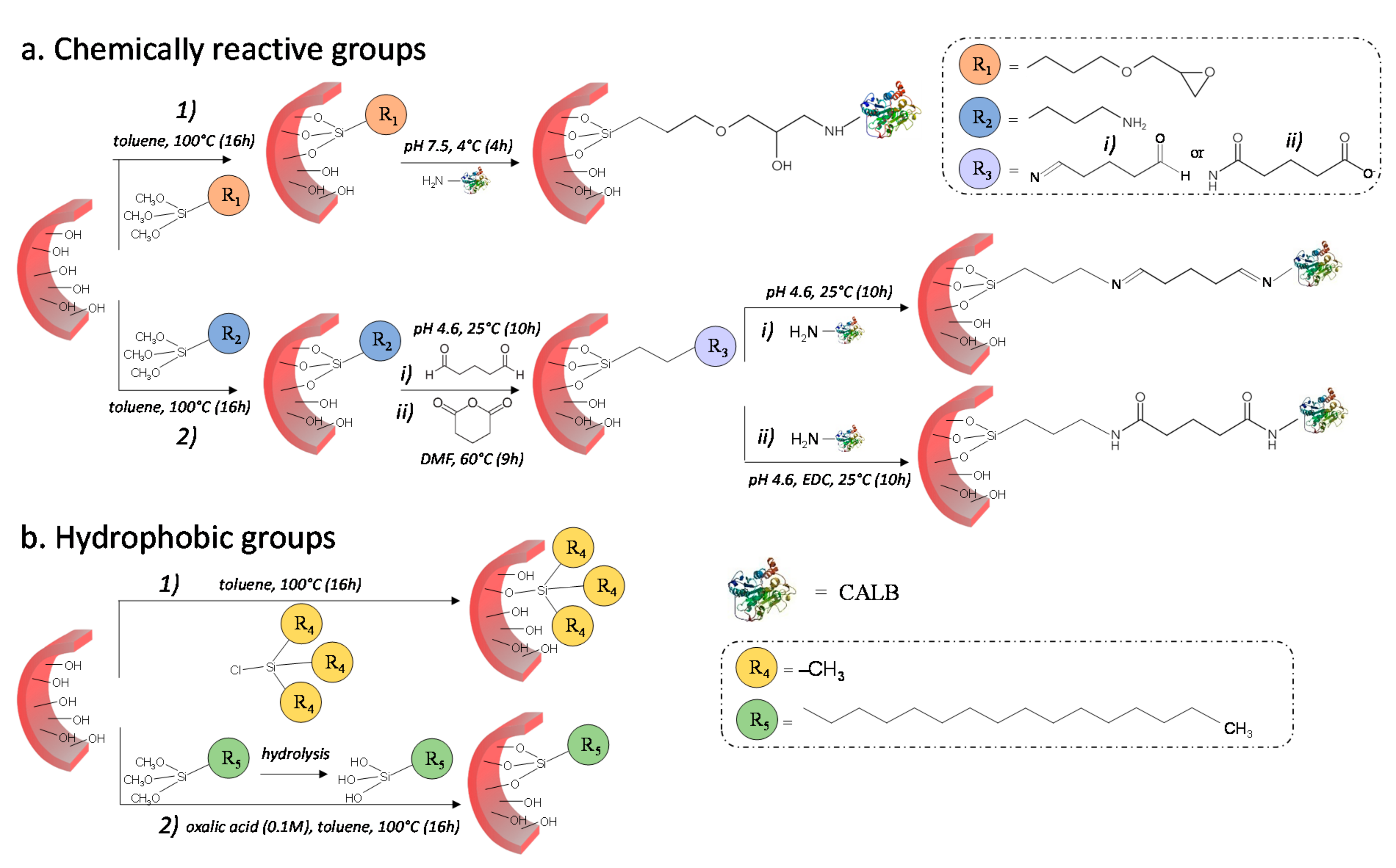
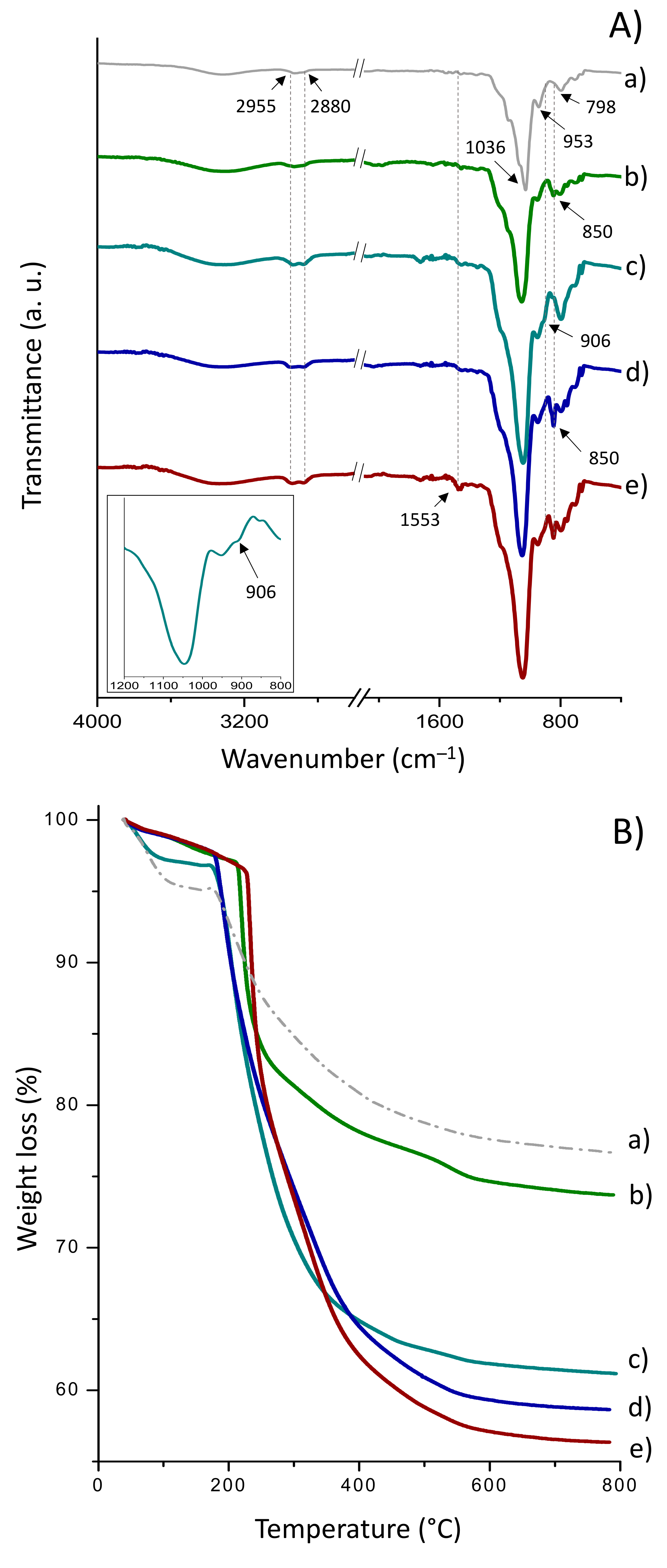
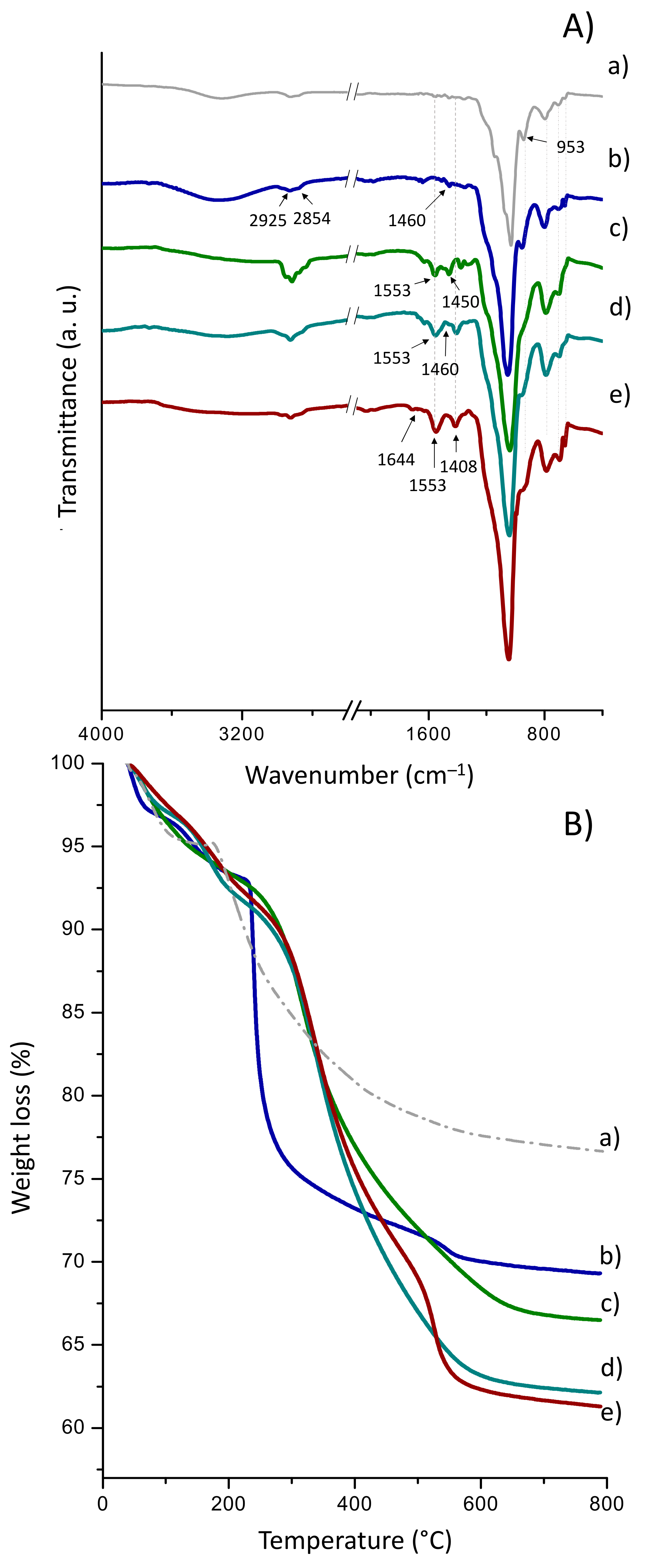
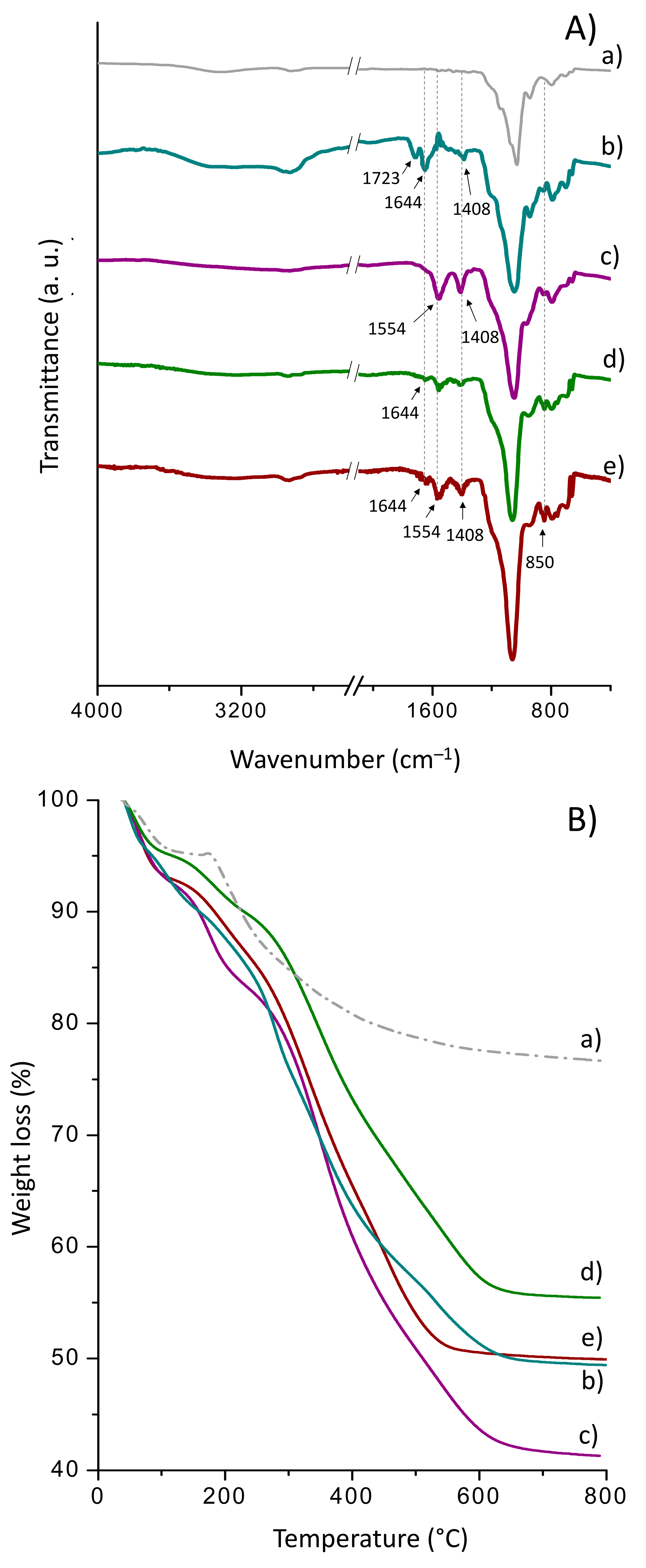
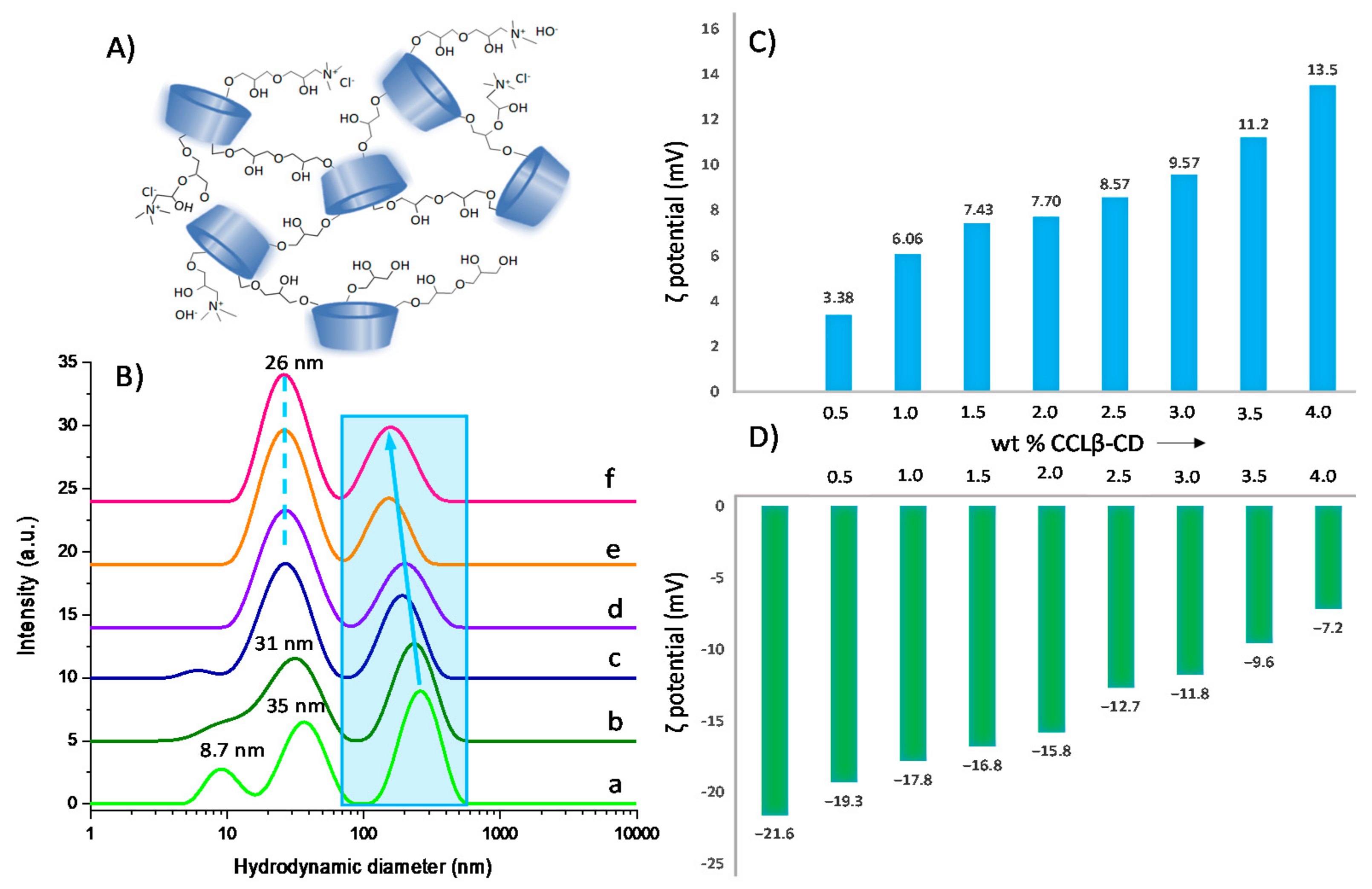

| Sample | Total Weight Loss a (%) | Effective Weight Loss b (%) | Dg c (mg·g−1) | Dgmax, d (mg·g−1) | Scov e (chain·nm−2) |
|---|---|---|---|---|---|
| Sihgel@CTMS0.33 | 22.3 | 4.5 | 45 | 57 | 0.24 |
| Sihgel@GPTMS0.68 | 35.2 | 17.4 | 174 | 105 | 0.41 |
| Sihgel@CTMS0.33@GPTMS0.68 | 38.5 | 20.7 | 207 | - | - |
| Sihgel@CTMS0.33@GPTMS0.68@CALB | 41.0 | 2.5 | 25 | - | - |
| Sihgel@HDTMS0.33 | 24.5 | 6.7 | 67 | 85 | 0.07 |
| Sihgel@APTMS0.16 | 27.1 | 9.3 | 93 | 68 | 0.28 |
| Sihgel@HDTMS@APTMS-GAH | 31.1 | 13.3 | 133 | - | - |
| Sihgel@HDTMS@APTMS-GAH@CALB | 32.5 | 1.4 | 14 | - | - |
| Sihgel@CTMS@APTMS-GAC | 39.2 | 21.4 | 214 | - | - |
| Sihgel@CTMS@APTMS-GAC@CALB | 45.7 | 6.5 | 65 | - | - |
| Sihgel@CTMS@APTMS-GAH | 35.9 | 18.1 | 181 | - | - |
| Sihgel@CTMS@APTMS-GAH@CALB | 41.3 | 5.4 | 54 | - | - |
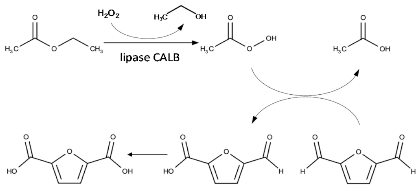 | |||||||||
|---|---|---|---|---|---|---|---|---|---|
| Entry | Catalyst | Immobilization Efficiency (%) b | Loading Capacity (wt.%) c | DFF Conversion (%) | Yield (%) | Specific Activity (µmol g−1 min−1) g | TTN (mol mol−1) h | TOF (min−1) i | |
| FFCA (%) | FDCA (%) | ||||||||
| 1 | free CALB | - | - | 0 | 0 | 0 | 0 | 0 | 0 |
| 2 | Sihgel@CTMS0.33 d @CALB2 e | 95 | 9.5 | 88 | 69 | 19 | 8.5 | 117.4 | 16.8 |
| 3 | Sihgel@CTMS0.33@CALB4 | 95 | 19 | 100 | 28 | 72 | 18.0 | 250.1 | 35.7 |
| 4 | Sihgel@CTMS0.33@GPTMS0.68@CALB2 | 96 | 9.6 | 100 | 58 | 42 | 20.8 | 288.8 | 41.3 |
| 5 | Sihgel@CTMS0.33@GPTMS1.00@CALB2 | 97 | 9.7 | 100 | 61 | 39 | 19.1 | 265.4 | 37.9 |
| 6 | Sihgel@CTMS0.33@GPTMS1.50@CALB2 | 97 | 9.7 | 100 | 66 | 34 | 16.7 | 231.3 | 33.0 |
| 7 | Sihgel@CTMS0.33@GPTMS0.68@CALB4 | 89 | 17.8 | 100 | 30 | 70 | 18.7 | 259.6 | 37.1 |
| 8 | Sihgel@CTMS0.33@GPTMS0.34@CALB4 | 96 | 19.2 | 100 | 49 | 51 | 12.6 | 175.3 | 25.0 |
| 9 | Sihgel@CTMS0.66@GPTMS0.68@CALB4 | 92 | 18.4 | 100 | 59 | 41 | 10.6 | 147.1 | 21.0 |
| 10 | Sihgel@CTMS0.66@GPTMS0.68@CALB8 | 96 | 38.4 | 100 | 28 | 72 | 8.9 | 123.8 | 17.7 |
| 11 | Sihgel@HDTMS0.33@CALB2 | 96 | 9.6 | 82 | 65 | 17 | 6.9 | 95.8 | 13.7 |
| 12 | Sihgel@HDTMS0.33@CALB4 | 99 | 19.8 | 100 | 50 | 50 | 12.0 | 166.7 | 23.8 |
| 13 | Sihgel@HDTMS0.33@CTMS0.33@CALB4 | 98 | 19.6 | 100 | 40 | 60 | 14.6 | 202 | 28.9 |
| 14 | Sihgel@APTMS0.16-GAH@CALB4 | 89 | 8.9 | 44 | 44 | 0 | 0.0 | 0.0 | 0.0 |
| 15 | Sihgel@HDTMS0.33@APTMS0.16-GAH@CALB2 | 96 | 9.6 | 85 | 72 | 13 | 5.5 | 76.0 | 10.9 |
| 16 | Sihgel@CTMS0.33@APTMS0.16-GAC@CALB2 | 95 | 9.5 | 100 | 59 | 41 | 20.6 | 284.8 | 40.7 |
| 17 | Sihgel@CTMS0.33@APTMS0.16-GAH@CALB2 | 96 | 9.6 | 100 | 33 | 67 | 33.2 | 460.6 | 65.8 |
| 18 | Sisg f @CTMS0.33@APTMS0.16-GAH@CALB2 | 72 | 7.2 | 24 | 24 | 0 | 0.0 | 0.0 | 0.0 |
Publisher’s Note: MDPI stays neutral with regard to jurisdictional claims in published maps and institutional affiliations. |
© 2021 by the authors. Licensee MDPI, Basel, Switzerland. This article is an open access article distributed under the terms and conditions of the Creative Commons Attribution (CC BY) license (https://creativecommons.org/licenses/by/4.0/).
Share and Cite
Decarpigny, C.; Ponchel, A.; Monflier, E.; Bleta, R. Effect of Functional Group on the Catalytic Activity of Lipase B from Candida antarctica Immobilized in a Silica-Reinforced Pluronic F127/α-Cyclodextrin Hydrogel. Gels 2022, 8, 3. https://doi.org/10.3390/gels8010003
Decarpigny C, Ponchel A, Monflier E, Bleta R. Effect of Functional Group on the Catalytic Activity of Lipase B from Candida antarctica Immobilized in a Silica-Reinforced Pluronic F127/α-Cyclodextrin Hydrogel. Gels. 2022; 8(1):3. https://doi.org/10.3390/gels8010003
Chicago/Turabian StyleDecarpigny, Cédric, Anne Ponchel, Eric Monflier, and Rudina Bleta. 2022. "Effect of Functional Group on the Catalytic Activity of Lipase B from Candida antarctica Immobilized in a Silica-Reinforced Pluronic F127/α-Cyclodextrin Hydrogel" Gels 8, no. 1: 3. https://doi.org/10.3390/gels8010003
APA StyleDecarpigny, C., Ponchel, A., Monflier, E., & Bleta, R. (2022). Effect of Functional Group on the Catalytic Activity of Lipase B from Candida antarctica Immobilized in a Silica-Reinforced Pluronic F127/α-Cyclodextrin Hydrogel. Gels, 8(1), 3. https://doi.org/10.3390/gels8010003





